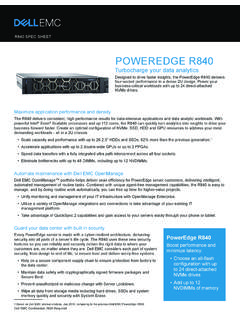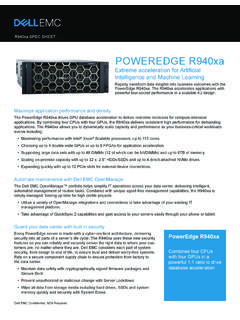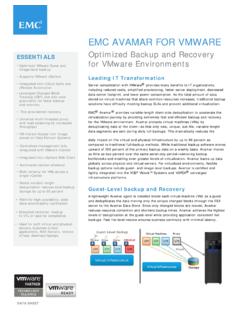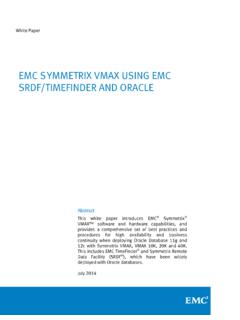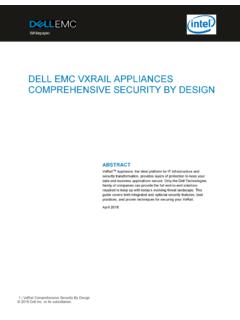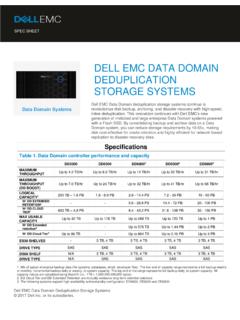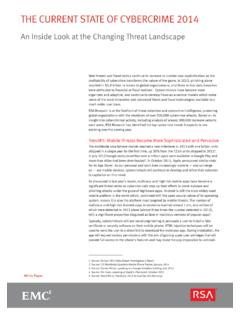Transcription of Hadoop on EMC Isilon Scale-out NAS
1 White Paper Abstract This white paper details the way EMC Isilon Scale-out NAS can be used to support a Hadoop data analytics workflow for an enterprise. It describes the core architectural components involved as well as highlights the benefits that an enterprise can leverage to gain reliable business insight quickly and efficiently while maintaining simplicity to meet the storage requirements of an evolving Big Data analytics workflow. December 2012 Hadoop ON EMC Isilon Scale-out NAS 2 Hadoop on EMC Isilon Scale-out NAS Copyright 2012 EMC Corporation. All Rights Reserved. EMC believes the information in this publication is accurate as of its publication date. The information is subject to change without notice. The information in this publication is provided as is. EMC Corporation makes no representations or warranties of any kind with respect to the information in this publication, and specifically disclaims implied warranties of merchantability or fitness for a particular purpose.
2 Use, copying, and distribution of any EMC software described in this publication requires an applicable software license. For the most up-to-date listing of EMC product names, see EMC Corporation Trademarks on VMware is a registered trademark or trademark of VMware, Inc. in the United States and/or other jurisdictions. All other trademarks used herein are the property of their respective owners. Part Number 3 Hadoop on EMC Isilon Scale-out NAS Table of Contents Introduction .. 4 Hadoop Software Overview .. 4 Hadoop MapReduce .. 5 Hadoop Distributed Filesystem .. 5 Hadoop Distributions .. 6 Hadoop Ecosystem .. 6 Hadoop Architecture .. 7 EMC Isilon OneFS Overview .. 7 Isilon Architecture .. 8 OneFS Optional Software Modules .. 9 Hadoop On Isilon .. 10 Simplicity .. 11 Efficiency .. 12 Flexibility .. 13 Reliability .. 14 File System Journal .. 15 Proactive Node/Device Failure .. 15 Isilon Data Integrity .. 15 Protocol Checksums .. 16 Dynamic Sector Repair.
3 16 Mediascan .. 16 Integrity Scan .. 16 Data High Availability .. 17 Business Continuity .. 17 Conclusion .. 21 About Isilon .. 21 4 Hadoop on EMC Isilon Scale-out NAS Introduction Enterprises have been continuously dealing with storing and managing rapidly growing amounts of data, also known as Big Data. Though drive sizes have expanded to keep up with the compute capacity, the tools to analyze this Big Data and produce valuable insight has not kept up with this growth. Existing analytics architectures have proven to be too expensive and too slow. They have also been very challenging to maintain and manage. Hadoop is an innovative open source Big Data analytics engine that is designed to minimize time to derive valuable insight from an enterprise s dataset. It is comprised of two major components; MapReduce and the Hadoop distributed file system (HDFS). MapReduce is the distributed task processing framework that runs jobs in parallel on multiple nodes to derive results faster from large datasets.
4 HDFS is the distributed file system that a Hadoop compute farm uses to store all the input data that needs to be analyzed as well as any output produced by MapReduce jobs. Hadoop is built on principles of Scale-out and uses intelligent software running on a cluster of commodity hardware to quickly and cost effectively derive valuable insight. It is this distributed parallel task processing engine that makes Hadoop superb to analyze Big Data. Enterprises have continued to rely on EMC s Isilon Scale-out network attached storage (NAS) for various Big Data storage needs. OneFS is the operating system as well as the underlying distributed file system that runs on multiple nodes that form the EMC Isilon Scale-out NAS. OneFS is designed to scale not just in terms of machines, but also in human terms allowing large- scale systems to be managed with a fraction of the personnel required for traditional storage systems. OneFS eliminates complexity and incorporates self-healing and self-managing functionality that dramatically reduces the burden of storage management.
5 OneFS also incorporates parallelism at a very deep level of the OS, such that every key system service is distributed across multiple units of hardware. This allows OneFS to scale in virtually every dimension as the infrastructure is expanded, ensuring that what works today, will continue to work as the dataset grows and workflows change. This ability to be flexible and adapt to not only changing infrastructure and data capacity needs but also to adapt to evolving workflows with simplicity and ease makes EMC Isilon Scale-out NAS an extremely attractive element of a Big Data storage and analytics workflow solution using Hadoop . Hadoop Software Overview Hadoop is an industry leading innovative open source Big Data analytics engine that is designed to minimize time to derive valuable insight from an enterprise s dataset. Below are the key components of Hadoop : Hadoop MapReduce: the distributed task processing framework that runs jobs in parallel on large datasets across a cluster of compute nodes to derive results faster.
6 5 Hadoop on EMC Isilon Scale-out NAS Hadoop Distributed File System (HDFS): the distributed file system that a Hadoop compute farm uses to store all the data that needs to be analyzed by Hadoop . MapReduce as a computing paradigm was introduced by Google and Hadoop was written and donated to open source by Yahoo as an implementation of that paradigm. Hadoop MapReduce Hadoop MapReduce is a software framework for easily writing applications which process large amounts of data in-parallel on large clusters of commodity compute nodes. The MapReduce framework consists of the following: JobTracker: single master per cluster of nodes that schedules, monitors and manages jobs as well as its component tasks. TaskTracker: one slave TaskTracker per cluster node that execute task components for a job as directed by the JobTracker. A MapReduce job (query) comprises of multiple map tasks which are distributed and processed in a completely parallel manner across the cluster.
7 The framework sorts the output of the maps, which are then used as input to the reduce tasks. Typically both the input and the output of the job are stored across the cluster of compute nodes using HDFS. The framework takes care of scheduling tasks, monitoring them and managing the re-execution of failed tasks. Typically in a Hadoop cluster, the MapReduce compute nodes and the HDFS storage layer (HDFS) reside on the same set of nodes. This configuration allows the framework to effectively schedule tasks on the nodes where data is already present in order to avoid network bottlenecks involved with moving data within a cluster of nodes. This is how the compute layer derives key insight efficiently by aligning with data locality in the HDFS layer. Hadoop is completely written in Java but MapReduce applications do not need to be. MapReduce applications can utilize the Hadoop Streaming interface to specify any executable to be the mapper or reducer for a particular job.
8 Hadoop Distributed Filesystem HDFS is a block based file system that spans multiple nodes in a cluster and allows user data to be stored in files. It presents a traditional hierarchical file organization so that users or applications can manipulate (create, rename, move or remove) files and directories. It also presents a streaming interface that can be used to run any application of choice using the MapReduce framework. HDFS does not support setting hard or soft links and you cannot seek to particular blocks or overwrite files. HDFS requires programmatic access and so you cannot mount it as a file system. All HDFS communication is layered on top of the TCP/IP protocol. Below are the key components for HDFS: 6 Hadoop on EMC Isilon Scale-out NAS NameNode: single master metadata server that has in-memory maps of every file, file locations as well as all the blocks within the files and which DataNodes they reside on. DataNode: one slave DataNode per cluster node that serves read/write requests as well as performs block creation, deletion and replication as directed by the NameNode.
9 HDFS is the storage layer where all the data resides before a MapReduce job can run on it. HDFS uses block mirroring to spread the data around in the Hadoop cluster for protection as well as data locality across multiple compute nodes. The default block size is 64 MB and the default replication factor is 3x. Hadoop Distributions The open source Apached Foundation maintains releases of Apache Hadoop at All other distributions are derivatives of work that build upon or extend Apache Hadoop . Below is a list of common Hadoop distributions that are available today: Apache Hadoop Cloudera CDH3 Greenplum HD Hortonworks Data Platform The above list is not an exhaustive list of all the Hadoop distributions available today but a snapshot of popular choices. A detailed list of Hadoop distributions available today can be found at: This is the software stack that customers run to analyze data with Hadoop . Hadoop Ecosystem The following is the software stack that customers run to analyze data with Hadoop .
10 The ecosystem components are add-on components that sit on top of the Hadoop stack to provide additional features and benefits to the analytics workflows. Some popular choices in this area are: Hive: a SQL-like, ad hoc querying interface for data stored in HDFS HBase: a high-performance random read/writeable column oriented structured storage system that sits atop HDFS Pig: high level data flow language and execution framework for parallel computation Mahout: scalable machine learning algorithms using Hadoop R (RHIPE): divide and recombine statistical analysis for large complex data sets 7 Hadoop on EMC Isilon Scale-out NAS The above is not an exhaustive list of all Hadoop ecosystem components. All components of Hadoop Hadoop Architecture Below is what an architecture diagram would look like that shows all of the core Hadoop components that run on a Hadoop compute cluster. The general interaction that happens in this compute environment are: 1.

